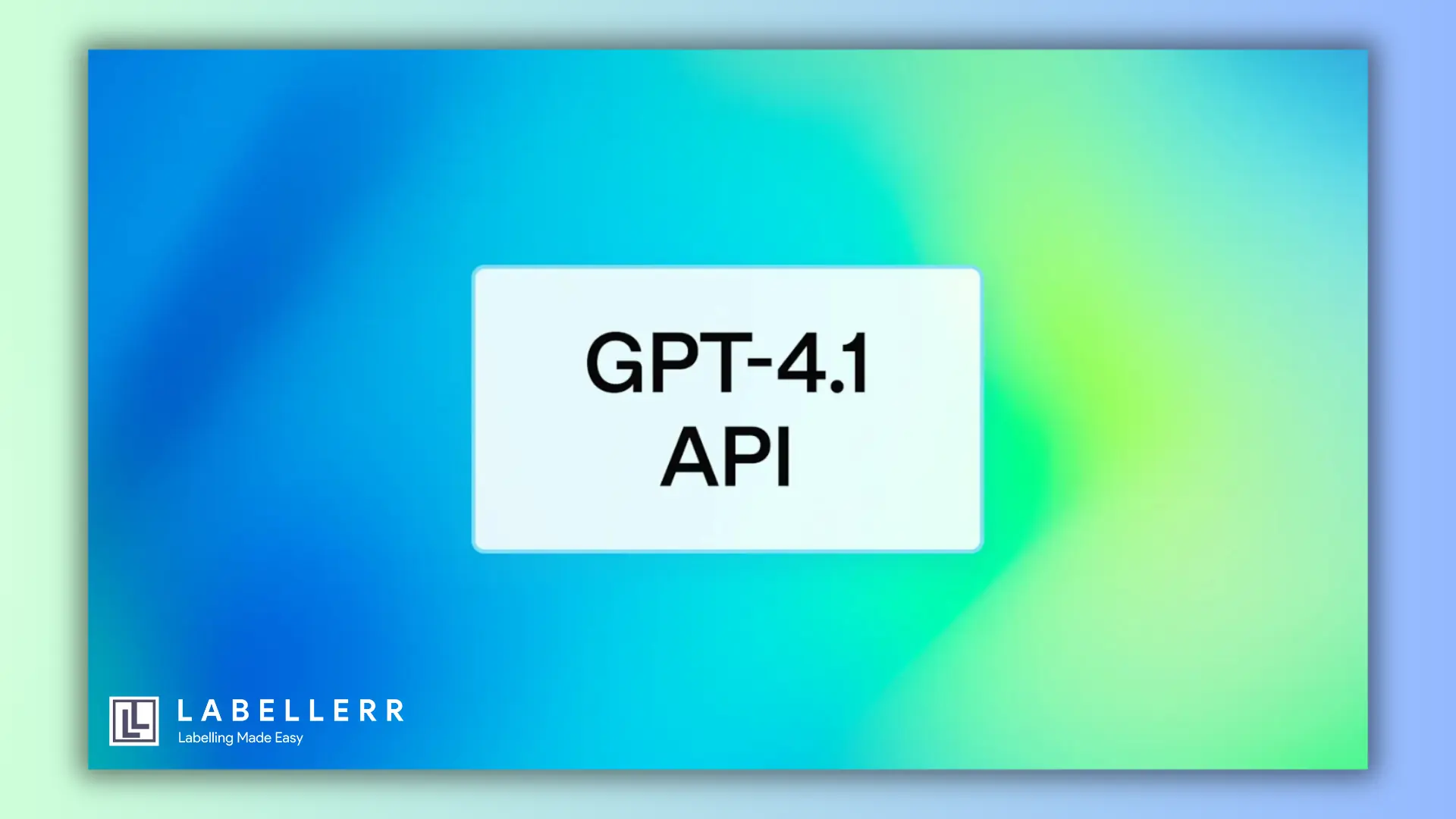GPT 4.1: Better and Cheaper Than GPT-4o?
GPT-4.1, OpenAI's latest model, surpasses GPT-4o with improved coding abilities, a massive 1 million token context window, and more affordable pricing. This article explores the advancements and benefits of GPT-4.1 for developers and businesses alike.

Last week, our team at Labellerr felt the familiar buzz around a new AI release: Meta's Llama 4. Like many, we had high hopes. Meta marketed it heavily, promising big leaps.
We dove into testing, eager to use it for our complex AI agent and data annotation work. But the reality quickly set in – Llama 4, for us, was a letdown.
We weren't alone. The AI community started buzzing with frustration. People found Llama 4 struggled with tasks it should have handled easily, especially given its massive size.
Its performance often didn't match the impressive benchmark scores Meta presented. We needed a reliable, powerful model. The question became: who could deliver?
Then, on April 14, OpenAI announced GPT-4.1. After the Llama 4 experience, we approached it with cautious optimism.
Could this new model be the reliable workhorse we needed? We rolled up our sleeves again. Here’s what we discovered comparing the two.
Why is GPT 4.1 So Special?

GPT-4.1 isn't just a small update; it has major improvements inside. OpenAI focused on making it reliable, powerful, and easy for developers to use.
Smarter Training
GPT-4.1 learned from a huge, updated collection of information (including data up to June 2024). OpenAI used better training methods. This helps the AI follow instructions more accurately and generate better code.
Context Window
A huge upgrade is its ability to handle up to 1 million tokens in a single request. Think of tokens as pieces of words.
This is 8 times bigger than the previous GPT-4o model! It means GPT-4.1 can read and understand entire books, very long reports, or large amounts of computer code without losing track.
This is great for complex tasks that need lots of background information.
Long Memory
GPT-4.1 uses new techniques to remember information from anywhere within that huge 1-million-token window. Tests show it can find specific details ("a needle in a haystack") even if they were mentioned much earlier in the text.
Better at Code and Instructions
OpenAI specifically worked on making GPT-4.1 better at technical tasks. It writes cleaner computer code and follows complicated, multi-step instructions more reliably.
It's also good at giving answers in specific formats (like lists, tables, or code blocks) and understanding "don't do this" instructions. This makes it great for building automated tools (AI agents).
Different Sizes for Different Needs
GPT-4. comes in the standard powerful version, plus new Mini and Nano versions.
These smaller models are faster and cheaper to run. They work well on devices like phones or for tasks that need quick responses without needing the absolute maximum power.
Safe and Secure for Business
OpenAI built in stronger safety features to reduce harmful or biased answers. They designed it to meet common business needs for data privacy and responsible AI use.
API Access Only (For Now)
You use GPT-4.1 through Cursor IDE, Github Copilot, Windsurf, OpenAI API & Playground, and Microsoft Azure OpenAI Service.
You can customize it for specific jobs by fine-tuning the standard or Mini versions. You cannot download and run it on your own computer currently.
Faster and Cheaper
Tests show GPT-4.1 performs better than older GPT-4 models on coding and following instructions. It often responds faster and costs less to use, especially with the new Mini and Nano options.
GPT 4.1 Benchmarks
We put GPT-4.1 through many tests. We focused on the areas where we found Llama 4 had problems: coding, following instructions, understanding long documents, and handling images/video.
Summary Table
Here's a quick comparison:
(Note: Llama 4 public versions generally scored lower than GPT-4o on comparable tests based on community reports and our findings).
Let's discuss what we found:
1. Coding Performance
- SWE-bench Verified: This test checks if the AI can fix actual programming bugs found on GitHub.
GPT-4.1 correctly fixed 54.6% of the issues.
This was a huge jump compared to older models like GPT-4o (which got 33.2%) and much better than Llama 4 performed in our tests. - Aider Polyglot Diff: We tested how accurately GPT-4.1 could make specific changes to existing code.
It achieved 52.9% accuracy, more than double GPT-4o's score. It also made very few unnecessary changes (only 2% compared to 9% for GPT-4o). - Developer Feedback: When we showed code generated by GPT-4.1 to human programmers, they preferred its output 80% of the time compared to older models. Other companies testing it reported big improvements too.
2. Following Instructions
- MultiChallenge & IFEval: GPT-4.1 scored 38.3% on MultiChallenge (up from 27.8% for GPT-4o) and 87.4% on IFEval (up from 81% for GPT-4o). These tests measure how well the AI follows detailed, multi-step instructions and formatting rules.
- Reliability for Automation: Because it follows complex instructions better, GPT-4.1 is much more reliable for building AI agents that need to perform specific sequences of tasks.
- Takes Things Literally: We noticed GPT-4.1 follows instructions very precisely. This is good for reliability, but sometimes you need to be extra clear in your prompts to get exactly what you want.
3. Long-Context Reasoning
- Huge Memory: All GPT-4.1 versions (standard, Mini, Nano) can handle up to 1 million tokens. This is 8 times more than GPT-4o's limit, and it doesn't cost extra to use the full window.
- Finding Details: OpenAI tested if GPT-4.1 could find a specific piece of information hidden anywhere inside a huge document.
It found the information correctly 100% of the time, no matter where it was hidden. This shows its memory works well across the entire 1 million tokens. - Graphwalks: On a test called Graphwalks, which checks if the AI can connect related pieces of information spread across a long document, GPT-4.1 scored 61.7% (much better than GPT-4o's 41.7%). Companies using it reported it was much better at analyzing multiple documents at once.
4. Multimodal Tasks
- Video-MME: We tested GPT-4.1 on understanding long videos (30-60 minutes) without subtitles. It scored 72.0%, beating GPT-4o (65.3%) and setting a new record for this difficult task.
- MMMU & MathVista: On tests that combine images with questions requiring reasoning (like math problems based on diagrams), GPT-4.1 also showed big improvements, scoring 74.8% on MMMU and 72.2% on MathVista.
- Small Models Are Good Too: Interestingly, the GPT-4.1 Mini version performed almost as well as the full version on some of these visual tasks. This makes Mini a great option if you need good visual understanding quickly and cheaply.
Building Vision Agents with GPT 4.1(Copilot)

Benchmarks and tests are one thing, but how does GPT-4.1 perform on actual development tasks? At Labellerr, we needed to build a complex tool, and this gave us a perfect chance to test GPT-4.1 in a real scenario, using it through GitHub Copilot.
The Challenge: Building a Vision AI Testbed
We wanted to create a backend system (using Flask, a Python web framework) for a specific workflow:
- Users upload an image or video.
- They choose an AI vision task (like finding objects, segmenting parts of the image, classifying the image, etc.).
- They select one or more AI models for that task (like different versions of YOLO for object detection, or Segment Anything for segmentation).
- The system runs the selected models (up to 5 at the same time) on the uploaded data.
- It shows the results side-by-side for easy comparison, similar to popular demo sites like YOLO-ARENA on Hugging Face.
Giving Complex Instructions to GPT-4.1
We wrote a detailed prompt explaining this entire workflow to Copilot, powered by GPT-4.1. We specified the tasks, example models, the parallel processing requirement, and the side-by-side comparison goal.
This was a complex set of instructions, involving different technologies and logical steps – exactly the kind of task where earlier models might get confused.
GPT-4.1's Smart Response: Planning the Structure
Instead of just starting to write code, GPT-4.1's first response was incredibly helpful. It proposed a complete file and folder structure for the Flask application.
It laid out where the main app file should go, where to put the routes for handling uploads and predictions, where the AI model logic should live (organized by task like object detection and segmentation), and even included folders for helper utilities and service handlers.
The Wow Moment: "Create Workspace"
Here’s what really impressed us: Right below the suggested file structure, Copilot presented a button labeled "Create Workspace".
We clicked it, and instantly, Copilot automatically created all the suggested folders and logically accurate Python files (.py) within our project. It built the entire application based on GPT-4.1's plan in a single click!
Conclusion
Our journey started with disappointment in Llama 4. Its real-world performance, especially in coding and following complex instructions, didn't meet our needs. Concerns about its "open" label and benchmark results also gave us pause.
Then came GPT-4.1. In our tests, it delivered where Llama 4 struggled. GPT-4.1 handled long documents reliably, followed instructions accurately, and generated useful code.
The seamless integration, like creating a project structure with one click in Copilot, showed its practical power.
While no AI is perfect, GPT-4.1 proved itself a much more capable and trustworthy tool for building demanding, real-world AI applications right now.
If you need strong performance and reliability, especially after facing issues with other models, GPT-4.1 is definitely worth checking out.
FAQs
Q1: What is GPT-4.1?
GPT-4.1 is OpenAI's newest large language model, offering enhanced coding performance, extended context handling up to 1 million tokens, and cost-effective usage compared to its predecessor, GPT-4o.
Q2: How does GPT-4.1 differ from GPT-4o?
GPT-4.1 outperforms GPT-4o in coding tasks, supports longer context windows, and is approximately 26% cheaper, making it a more efficient choice for developers.
Q3: What are the pricing details for GPT-4.1?
GPT-4.1 charges $2.00 per million input tokens and $8.00 per million output tokens, offering a more affordable solution compared to GPT-4o's rates.
Q4: Is GPT-4.1 available to all users?
Currently, GPT-4.1 is accessible via OpenAI's API, catering primarily to developers and businesses seeking advanced AI capabilities.

Simplify Your Data Annotation Workflow With Proven Strategies
.png)


